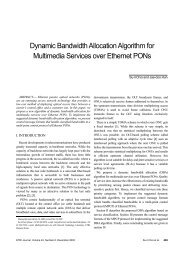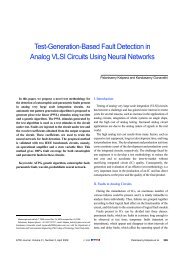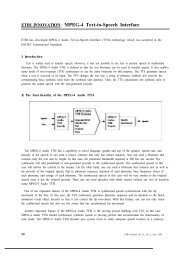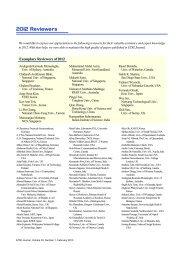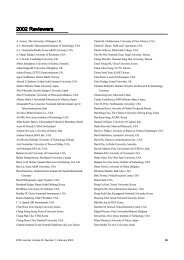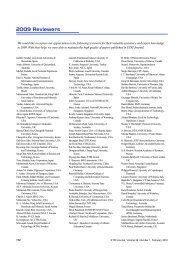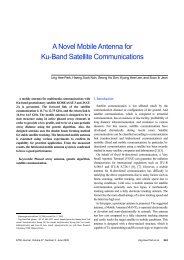Configuration of ACK Trees for Multicast Transport ... - ETRI Journal
Configuration of ACK Trees for Multicast Transport ... - ETRI Journal
Configuration of ACK Trees for Multicast Transport ... - ETRI Journal
Create successful ePaper yourself
Turn your PDF publications into a flip-book with our unique Google optimized e-Paper software.
<strong>for</strong> each parameter. These status values will be delivered to the<br />
sender via <strong>ACK</strong> packets. Sender aggregates the parameter status<br />
values reported from receivers. If a control tree is employed,<br />
each parent RH node aggregates the measured values reported<br />
from its children and <strong>for</strong>wards the aggregated values to its parent<br />
via its <strong>ACK</strong> packets.<br />
The sender takes QoS maintenance actions necessary to<br />
maintain the connection status at a desired QoS level, based on<br />
the monitored status values. Specific rules are pre-configured to<br />
trigger QoS maintenance actions such as data transmission rate<br />
adjustment, connection pause and resume, and connection termination.<br />
Those rules are based on observation that how many<br />
receivers are in the abnormal or possibly abnormal status.<br />
The sender terminates the connection by sending a termination<br />
message to all the receivers after all the multicast data are<br />
transmitted. The connection may also terminate due to a fatal<br />
protocol error such as connection failure.<br />
III. BOTTOM-UP TREE CONFIGURATION<br />
The tree configuration currently proposed in IETF [9] can be<br />
considered as a bottom-up approach from the viewpoint that all<br />
the leaf receivers try to find their parent RH nodes in parallel<br />
and the tree is expanded from the leaf receivers toward the root<br />
sender.<br />
A generic tree configuration proceeds in the order <strong>of</strong> session<br />
advertisement, RH discovery, and binding to the best RH. In<br />
the session advertisement, each receiver realizes the existence<br />
<strong>of</strong> a session and the sender by using an out-<strong>of</strong>-band mechanism<br />
such as Web page announcement. In this way, the receiver will<br />
obtain the multicast group address and the sender’s address,<br />
and the other in<strong>for</strong>mation necessary <strong>for</strong> the <strong>ACK</strong> tree construction.<br />
When the sender indicates the creation <strong>of</strong> an <strong>ACK</strong> tree,<br />
each receiver begins the RH discovery process to find one or<br />
more candidate RH nodes that are active in the session. Among<br />
the candidate RH nodes discovered, a receiver selects and<br />
binds to the best RH node as its parent by using a preconfigured<br />
rule such as TTL distance or IP address.<br />
Depending on the RH discovery mechanism employed, the<br />
detailed tree configuration procedures are slightly different from<br />
each other. In [9], three different RH discovery mechanisms are<br />
provided: point <strong>of</strong> contact (POC) based, generic router assist<br />
(GRA) based and expanding ring search (ERS) based.<br />
A POC is a dedicated server that is established <strong>for</strong> the <strong>ACK</strong><br />
tree construction in the network. Each RH node enrolls itself to<br />
the POC which is located in its domain. Each receiver asks the<br />
POC “which RH nodes are active in the domain.” The POC<br />
then responds to the receiver with a list <strong>of</strong> active RH nodes.<br />
The GRA approach tries to construct an <strong>ACK</strong> tree that keeps<br />
congruency with the underlying multicast routing tree topology.<br />
To do this, each GRA router collects the routing tree in<strong>for</strong>mation<br />
and delivers it to the downstream receivers <strong>for</strong> the associated<br />
multicast group.<br />
In the ERS-based scheme, a receiver discovers the RH nodes<br />
by using multicast query messages. Each receiver first asks if<br />
there is a neighboring RH node by multicast. One or more RH<br />
nodes may respond to the query message. If there is no response<br />
from RH nodes, the receiver will re-send the query<br />
messages with an increased TTL value until at least one RH<br />
node is discovered.<br />
We note that both POC and GRA schemes depend on the<br />
dedicated facilities such as POC servers or GRA routers that<br />
have been pre-configured in the network. The corresponding<br />
per<strong>for</strong>mance <strong>for</strong> the tree configuration also depends on how<br />
much those facilities are deployed. This paper thus focuses on<br />
the ERS-based scheme as a promising bottom-up tree configuration<br />
scheme.<br />
The ERS-based bottom-up tree configuration scheme is illustrated<br />
in Fig. 3, and the control messages employed <strong>for</strong> the<br />
tree configuration are summarized in Table 1.<br />
For tree configuration, the sender first indicates the tree creation<br />
by sending a session BEACON message to all the receivers<br />
and RH nodes.<br />
BIND<br />
ACCEPT<br />
BEACON<br />
QUERY<br />
BIND<br />
ADVERTISE<br />
ACCEPT or REJECT<br />
Sender Repair Head Receiver<br />
Fig. 3. ERS-based bottom-up configuration scheme.<br />
Table 1. Control messages employed <strong>for</strong> the ERS-based bottom-up<br />
configuration.<br />
Message<br />
Types From To <strong>Transport</strong> Description<br />
BEACON Sender Receivers <strong>Multicast</strong><br />
Indication <strong>of</strong> tree<br />
creation<br />
QUERY Receiver RHs <strong>Multicast</strong><br />
Finding candidate<br />
RHs<br />
ADVERTISE RH Receivers <strong>Multicast</strong> Response from RH<br />
BIND Receiver RH Unicast Bind request<br />
ACCEPT or<br />
REJECT<br />
RH Receiver Unicast<br />
Response to the bind<br />
request<br />
114 Seok Joo Koh et al. <strong>ETRI</strong> <strong>Journal</strong>, Volume 23, Number 3, September 2001




